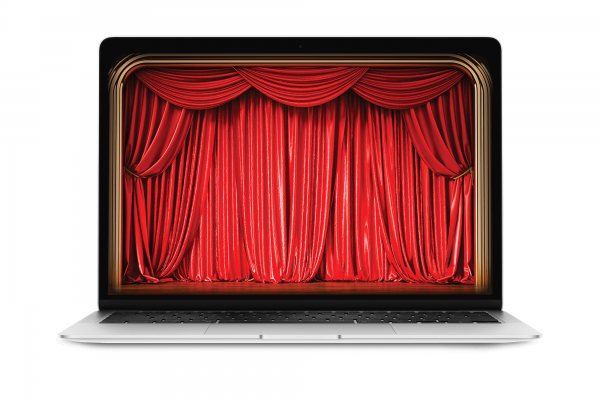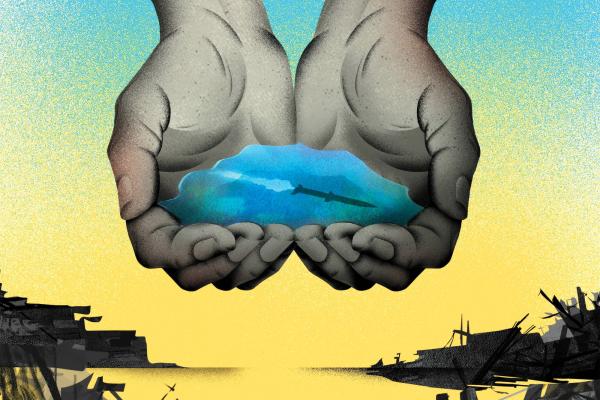WHEN WESTERN THEATER was born in the ancient Theatre of Dionysus some 2,500 years ago, its creators aspired to create a democratic institution, meant to serve the members of every tribe in Greece. The reality fell far short of the aspiration, of course, since women and slaves were excluded from both democracy and the grand stone auditorium. Nevertheless, the theater of Greece was born in a kind of perfect storm, a concurrence of democratic ideology and ideals—especially the belief in free speech for those deemed fit to govern (i.e., free men)—with a golden age of literature. This era brought about some of the most powerful dramatic works known to humanity in the plays of Aeschylus, Sophocles, Euripides, and Aristophanes.
We could be at the brink of another golden age for theater, arising from changes caused by the coronavirus pandemic. How can I say this, when most of those who work in the theater are worried about how theatrical institutions will survive this crisis? Joseph Haj, artistic director of the Guthrie Theater in Minneapolis, notes that theater has endured for centuries “because it is one of society’s proven necessities, not some old-fashioned practice.” It’s a necessity because humans need to gather to hear our stories and find safety in being together—the communal theater experience pushes back at the dangers and sadness that surround us.
And yet the questions abound: Will there be enough funding, public and private, to keep theaters afloat? Will audiences come if they are living in fear? Funding and sufficient audience support were worries before the pandemic hit, even as theatrical writing and technique thrived during the past decade, releasing many new voices onto public stages. The problem is that when a theater ticket often costs upward of $100, few people can afford access to these new voices. Despite the democratic ideals at its roots, U.S. live theater has served a very small, mostly white, upper-middle-class audience. The main exceptions are the rare state and federal grants that provide broader access through educational programs.
But since the pandemic has emptied theaters, some important lessons are being learned about audiences and access. Across the U.S. and around the globe, from the National Theatre in London to Chicago’s Goodman Theatre, from the Metropolitan Opera to Los Angeles Theatre Works—and, of course, in the phenomenon that is Hamilton—theater has become accessible to anyone with adequate internet access, which of course still excludes millions. Through streaming, the potential audience for theater is expanded around the world.
It’s true that encountering theater through a screen doesn’t produce the same camaraderie and societal discourse as being physically present at a live event, where it’s been proven that our hearts begin beating in unison as we experience the dramatic arc of a story together. However, having some of the transformative power of drama and other performing arts available to more people virtually is still hopeful, and far better than no access at all.
Several playwrights echo this hope. “I think we are hungry for connection,” says renowned playwright and librettist Deborah Brevoort. “We need works that provide meaning and uplift. That’s what music, concerts, and online performances are giving us now. And we need this same level of access to continue after the pandemic is over.” During the Works Progress Administration of the 1930s, the Federal Theatre Project gave away tens of thousands of free tickets to the American public to keep the theater alive and well. Theaters, government arts programs, and other arts funders could explore how to adapt this model to our own time and technology.
In some ways this moment has had an equalizing effect on how people perceive and participate in the arts. “The exciting thing is, when everyone was sheltering in place, people got creative immediately; they had online talks and online stuff,” says New York-based playwright Arlene Hutton, who is also a recent coronavirus survivor. “Everyone is amateur now, even celebrities—on Zoom or Facebook, we all look amateur and we’re all having the same technical problems.” How can we enable more people at all levels of experience to come together—virtually, or post-pandemic, physically—to create and perform in the future? In assessing this we can’t ignore how too few people have access to arts education and other opportunities to learn to make stories together. Thriving arts programs in all schools would help build a stronger society.
Playwright Crystal Skillman sees the current crisis “as a moment of challenge, a moment that is teaching us how to be better artists and make a better world.” As more people experience great theater online and listen together to stories, they are learning that—now more than ever—sharing stories and performance is vital to humanity. People are hungry for places to laugh and cry together, to sing and dance together, places where our vulnerabilities are revealed on the stage, just as they were 2,500 years ago when theater in the West was born.
Live theater has, without a doubt, suffered in this pandemic. But the current crisis may also be the opening needed to bring more democracy to the U.S. stage and audience.

Got something to say about what you're reading? We value your feedback!







